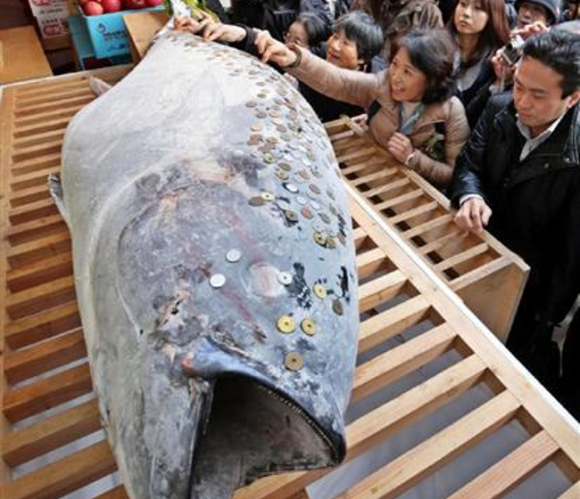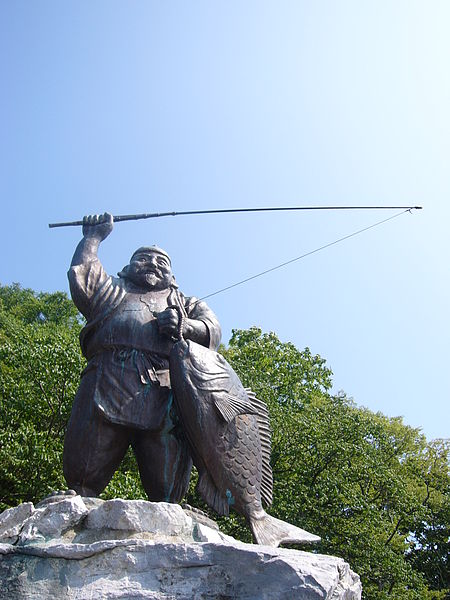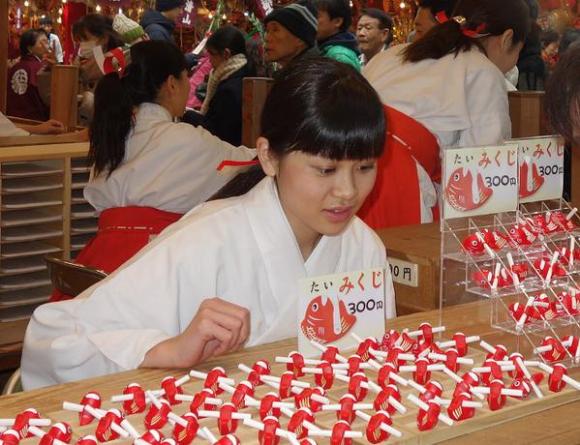
The start of a new year means it’s time for hatsumōde, the year’s first visit to a Shinto shrine or Buddhist temple. You pray for good luck in the new year, throw some spare yen into the saisenbako (big offering box), get some omamori (good luck charms), and hope that the omikuji (fortune) you get is dai-kichi (great luck) and not dai-kyō (you’re screwed).
While most people are satisfied donating a few yen coins in the donation box when they visit their shrine, the Nishinomiya shrine in Hyogo Prefecture does things a little differently. They want to make sure the gods hear them loud and clear, so they lug a massive frozen maguro onto the donation box and leave it there for three days.
This wasn’t an act of maguro vigilantes or anything though. It’s a yearly tradition dating back to 1970, sponsored by the Kobe City Eastern Marine Products Wholesale Cooperative. Every year they donate a giant frozen maguro to the Nishinomiya Shrine, the main shrine to Ebisu – Shinto god of prosperous business and fishermen.
▼ He’s pretty much the best god that fishermen looking for good business could ever hope for.

Since maguro are big, expensive, and impressive, they’re the perfect offering to the god of fishermen. The maguro is brought to the shrine each year on January 8, then stays there from the 9th to 11th during a three-day festival known as “The 10th Day Ebisu.” It’s the biggest yearly festival in the Osaka/Kobe area, bringing in over one million people.
Instead of donating yen coins normally into the donation box during that time, visitors instead stick them onto the frozen maguro, hoping that it will stay on. If the coin sticks, that means that money will “stick” to them during the new year as well. If it falls, well, then better luck next maguro.
You can watch a video of some people trying their luck here:
The maguro itself is quite a specimen, weighing in at 250 kilos (551 pounds) and 2.5 meters (8.2 feet) long. Just by itself it could supply enough delicious sashimi for 1,300 people. And don’t worry, none of it goes to waste. After the festival is over on the 11th, the maguro is removed, cut up, and served as a tasty treat to members of the shrine, the cooperative, and anyone else involved in the whole maguro business.
But just in case you got a bad fortune or your yen didn’t stick to the maguro and you feel like you really need to get some luck for the new year, the Nishinomiya Shrine also holds a “lucky man” event in the early morning on January 10. Participants line up at the front entrance, then sprint 230 meters (755 feet) as fast as they can through the shrine grounds and into the inner sanctuary, being rewarded with some rice, sake, wooden statues of Ebisu, and, if they’re lucky, a hug or two from the priests.
▼ It’s kind of like Japanese Black Friday, minus the terrible.
If you can’t visit the shrine yourself, feel free to buy some frozen tuna, stick some coins to it, and pray for good luck in the new year as it defrosts in your kitchen sink. Or, if you’d prefer, you can just take a look at some tweets from the shrine’s visitors who got to see the “lucky maguro” in person.
▼ Get all your shopping done at the Nishinomiya Shrine!
昨日、西宮神社に奉納された「招福大まぐろ」。体長2.5m、重さ250㎏の鹿児島産本まぐろです。「お金が身につく」ということで、参拝者の皆さんが、カチカチに凍った身に、さい銭を貼り付けています。 pic.twitter.com/E4YEWuBSvM
— 西宮観光協会 ◇ まちたびにしのみや (@2438kanko) January 9, 2015
▼ Shh, maguro is sleeping.
西宮神社行ってきた〜
— 悠平 (@yuu1814) January 10, 2015
人多いけど屋台食べ歩いた‼︎
後まぐろ大きかった! pic.twitter.com/3mMQif8F0c
▼ Try your luck at picking a good mikuji (fortune)!
▼ …and if you get a bad one, well, maybe Ebisu will show up and make everything all right.
Source: Naver Matome
Featured/top image: Twitter



 Japanese shrine maidens in Osaka spotted wearing unusual costumes during winter
Japanese shrine maidens in Osaka spotted wearing unusual costumes during winter Fish on new Yebisu “happy” beer cans changes colour when chilled
Fish on new Yebisu “happy” beer cans changes colour when chilled Busting one of the biggest myths about the five-yen coin and shrine offerings in Japan
Busting one of the biggest myths about the five-yen coin and shrine offerings in Japan Five Japanese shrines to visit for wealth and prosperity in the Year of the Snake
Five Japanese shrines to visit for wealth and prosperity in the Year of the Snake Studio Ghibli releases a Totoro daruma and beckoning Catbus in Japan for New Year
Studio Ghibli releases a Totoro daruma and beckoning Catbus in Japan for New Year Hayao Miyazaki says Happy New Year to Studio Ghibli fans with new art for Year of the Horse
Hayao Miyazaki says Happy New Year to Studio Ghibli fans with new art for Year of the Horse We revisited Sweets Paradise after a decade to see if Japan’s dessert buffet still delivers
We revisited Sweets Paradise after a decade to see if Japan’s dessert buffet still delivers Japanese company selling bear-proof automatic doors
Japanese company selling bear-proof automatic doors Japanese-style accommodation at the new Premium Dormy Inn hotel in Asakusa will blow your mind
Japanese-style accommodation at the new Premium Dormy Inn hotel in Asakusa will blow your mind Is this the most relaxing Starbucks in Japan?
Is this the most relaxing Starbucks in Japan? Super Mario and Baskin-Robbins release a power-up ice cream collection in Japan
Super Mario and Baskin-Robbins release a power-up ice cream collection in Japan That time Seiji called JASRAC to ask why he didn’t get paid royalties for his song being on TV
That time Seiji called JASRAC to ask why he didn’t get paid royalties for his song being on TV Are all Starbucks coffee sizes the same? Testing the viral video claim in Japan
Are all Starbucks coffee sizes the same? Testing the viral video claim in Japan McDonald’s releases new “Yakki” burger based on a popular Japanese meal
McDonald’s releases new “Yakki” burger based on a popular Japanese meal Godzilla-shaped ice cream on sale in Tokyo near the sight his most adorable rampage
Godzilla-shaped ice cream on sale in Tokyo near the sight his most adorable rampage Starbucks Japan ready to get Year of the Horse started with adorable drinkware and plushies【Pics】
Starbucks Japan ready to get Year of the Horse started with adorable drinkware and plushies【Pics】 Cyberpunk anime meets traditional culture in Ghost in the Shell gold leaf Japanese changing screens
Cyberpunk anime meets traditional culture in Ghost in the Shell gold leaf Japanese changing screens 7 great places to see Mt. Fuji from without having to climb it
7 great places to see Mt. Fuji from without having to climb it Hello Kitty Choco Egg figures are an adorable trip through three periods of Japanese pop culture【Pics】
Hello Kitty Choco Egg figures are an adorable trip through three periods of Japanese pop culture【Pics】 7-Eleven Japan’s ramen-cooking robot whipped us up a bowl of noodles【Taste test】
7-Eleven Japan’s ramen-cooking robot whipped us up a bowl of noodles【Taste test】 We found possibly the quietest Japanese-style hotel in Tokyo’s bustling Shinjuku district
We found possibly the quietest Japanese-style hotel in Tokyo’s bustling Shinjuku district Japan’s otoshidama tradition of giving kids money at New Year’s gets a social welfare upgrade
Japan’s otoshidama tradition of giving kids money at New Year’s gets a social welfare upgrade Sumo Sanrio! Hello Kitty and pals team up with Japan Sumo Association for new merch【Pics】
Sumo Sanrio! Hello Kitty and pals team up with Japan Sumo Association for new merch【Pics】 More Than a Capsule Stay: Why Solo Travelers Choose “global cabin Yokohama Chinatown”
More Than a Capsule Stay: Why Solo Travelers Choose “global cabin Yokohama Chinatown” Japan’s oldest largetooth sawfish in captivity back on display in Mie Prefecture
Japan’s oldest largetooth sawfish in captivity back on display in Mie Prefecture 7-Eleven Japan starts new temporary luggage storage service in over 300 branches
7-Eleven Japan starts new temporary luggage storage service in over 300 branches Disillusionment at Tsukiji’s tourist-target prices led us to a great ramen restaurant in Tokyo
Disillusionment at Tsukiji’s tourist-target prices led us to a great ramen restaurant in Tokyo Starbucks teams up with 166-year-old Kyoto doll maker for Year of the Horse decorations【Photos】
Starbucks teams up with 166-year-old Kyoto doll maker for Year of the Horse decorations【Photos】 Tokyo considering law requiring more trash cans following litter increase in heavily touristed area
Tokyo considering law requiring more trash cans following litter increase in heavily touristed area Tokyo’s Tsukiji sushi neighborhood asks tour groups to stay away for the rest of the month
Tokyo’s Tsukiji sushi neighborhood asks tour groups to stay away for the rest of the month Tokyo event lets you travel back in time, for free, to celebrate 100 years since Showa era start
Tokyo event lets you travel back in time, for free, to celebrate 100 years since Showa era start Sanrio theme park in Japan announces plans to expand into a Sanrio resort
Sanrio theme park in Japan announces plans to expand into a Sanrio resort Japan may add Japanese language proficiency, lifestyle classes to permanent foreign resident requirements
Japan may add Japanese language proficiency, lifestyle classes to permanent foreign resident requirements Stamina-destroying “Paralysis Noodles” are Tokyo’s newest over-the-top ramen innovation
Stamina-destroying “Paralysis Noodles” are Tokyo’s newest over-the-top ramen innovation Survey asks foreign tourists what bothered them in Japan, more than half gave same answer
Survey asks foreign tourists what bothered them in Japan, more than half gave same answer Japan’s human washing machines will go on sale to general public, demos to be held in Tokyo
Japan’s human washing machines will go on sale to general public, demos to be held in Tokyo Japan’s deadliest food claims more victims, but why do people keep eating it for New Year’s?
Japan’s deadliest food claims more victims, but why do people keep eating it for New Year’s? We deeply regret going into this tunnel on our walk in the mountains of Japan
We deeply regret going into this tunnel on our walk in the mountains of Japan Studio Ghibli releases Kodama forest spirits from Princess Mononoke to light up your home
Studio Ghibli releases Kodama forest spirits from Princess Mononoke to light up your home Major Japanese hotel chain says reservations via overseas booking sites may not be valid
Major Japanese hotel chain says reservations via overseas booking sites may not be valid Put sesame oil in your coffee? Japanese maker says it’s the best way to start your day【Taste test】
Put sesame oil in your coffee? Japanese maker says it’s the best way to start your day【Taste test】 No more using real katana for tourism activities, Japan’s National Police Agency says
No more using real katana for tourism activities, Japan’s National Police Agency says Starbucks Japan reveals new sakura drinkware collection, inspired by evening cherry blossoms
Starbucks Japan reveals new sakura drinkware collection, inspired by evening cherry blossoms Updated cherry blossom forecast shows extra-long sakura season for Japan this year
Updated cherry blossom forecast shows extra-long sakura season for Japan this year 42-year-old police sergeant disciplined for stealing about 200 yen from shrine donation box
42-year-old police sergeant disciplined for stealing about 200 yen from shrine donation box Man strips, makes it rain atop stone lantern at Ise Jingu shrine in Japan
Man strips, makes it rain atop stone lantern at Ise Jingu shrine in Japan Six things to avoid doing in the first three days of the Japanese New Year to have the best luck
Six things to avoid doing in the first three days of the Japanese New Year to have the best luck Aichi man arrested for failing to steal very large donation box from Shinto shrine
Aichi man arrested for failing to steal very large donation box from Shinto shrine The etiquette rules for visiting Shinto shrines in Japan
The etiquette rules for visiting Shinto shrines in Japan Is it OK to buy multiple shrine charms in Japan, or will it make the gods angry at you?
Is it OK to buy multiple shrine charms in Japan, or will it make the gods angry at you? Why is there a fish on this Shake Shack Japan T-shirt?
Why is there a fish on this Shake Shack Japan T-shirt? Hanazono Jinja Shrine: Lanterns, stalls and rakes at annual Tori no Ichi cock festival in Tokyo
Hanazono Jinja Shrine: Lanterns, stalls and rakes at annual Tori no Ichi cock festival in Tokyo Japanese man gets arrested for stealing 30 yen (US 27 cents) from Shinto shrine’s collection box
Japanese man gets arrested for stealing 30 yen (US 27 cents) from Shinto shrine’s collection box Imitation crab meat shrine built in Kobe
Imitation crab meat shrine built in Kobe 1,300-year-old Kyoto shrine changes bell policy following altercation with foreign tourists【Video】
1,300-year-old Kyoto shrine changes bell policy following altercation with foreign tourists【Video】 Cat in Japan finds the perfect shrine to take shelter from the rain at
Cat in Japan finds the perfect shrine to take shelter from the rain at Disney’s Japanese New Year’s plushies and figures are ready to make oshogatsu cuter than ever
Disney’s Japanese New Year’s plushies and figures are ready to make oshogatsu cuter than ever Thanks to the shogun, this Tokyo Shinto shrine has good luck charms to help you win idol tickets
Thanks to the shogun, this Tokyo Shinto shrine has good luck charms to help you win idol tickets Tokyo’s sushi spirit shrine, where the souls of seafood slumber
Tokyo’s sushi spirit shrine, where the souls of seafood slumber Real-life Ghost of Tsushima shrine announces ban of all “tourists,” but there’s some fine print
Real-life Ghost of Tsushima shrine announces ban of all “tourists,” but there’s some fine print
Leave a Reply